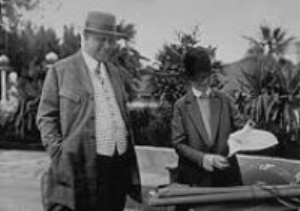The following is excerpted from the second issue (August 1, 1942) of The Marin-er, a house organ published bi-weekly by the Employee Relations Div. of Marinship Corp. Sausalito’s WWII shipyard became famous for meeting --- and, in some cases, exceeding -- these bold predictions.
With every worker taking part, Marinship is today aiming to set a new world record for speedy construction of steel cargo vessels.
Steve Bechtel speaks at first Keel Day program.
Photo courtesy of Sausalito Historical Society
The race to bring the world record crown to Marinship for its very first Liberty ship was begun on June 27, when the yard's first Keel Day was observed with brief "shirt-sleeve" ceremonies at Way No. 6. The race has been going on every hour of every day and night, and the ship has been growing before our eyes.
And if the men and women of Marinship can put it over — then they will show every other shipyard on the Pacific Coast and throughout the nation how we do things at Marinship—
And if we can follow this ship with many more in short order, we will show the Son of Heaven that his sun is about to set!
Some records have already been set at Marinship—
The war schedule called for pre-assembly of ship sections to start on June 1. This date was kept.
The war schedule called for the first keel to be laid on July 1. This deadline was beaten by four days!
Here's the confidence that S. D. "Steve" Bechtel, President of W. A. Bechtel Co., has in the men and women of Marinship. At Keel Day ceremonies, he prophesied that we will set a new world's record for fast shipbuilding at the time of our first launching! And he also prophesied that Marinship will produce more ships per way than any shipyard in the entire world!
He was introduced as "My brother Steve" by Kenneth K. Bechtel, Vice President in Charge of Marinship, who stated that this firm which started in 1925 as a "family business" has now grown into a "business family."
Representing Uncle Sam was Carl W. Flesher, Pacific Coast Regional Director for the Construction Divi-sion of the U. S. Maritime Commission, who told why our nation needs ships so desperately:
"To win this war we must carry our soldiers and equipment across 6,000 miles of water."
He commended the progress at Marinship as "more than satisfactory."
Chester L. Nelson, principal hull inspector at Marinship for the Maritime Commission, told why he expects big things:
"The Maritime Commission has installed the finest tools and equipment at Marinship for us to use."
About a thousand workers and guests attended the first Keel Day program which was put on under direction of Robert W. Adams, Employee Relations Manager.
While the crowd watched, cranes lifted two heavy steel plates and placed them end to end on the keel blocks. There amid the glare of a welder's arc the two sheets were joined—the beginning of a great ship, and perhaps a world record for Marinship.
Then, as the workers returned to their jobs, without a lost second the work went ahead at Way No. 6. Day and night the work has continued and still continues—
—to turn out our first ship in the fastest time ever seen, and to help speed Victory for our nation!
A new documentary, "Marinship, World's Most Amazing Shipyard" will debut at the Sausalito Library on Friday, March 3 at 7:00 PM. Following the screening, the Historical Society will host a reception in upstairs, launching its new exhibit “Marinship – What it Was.”



